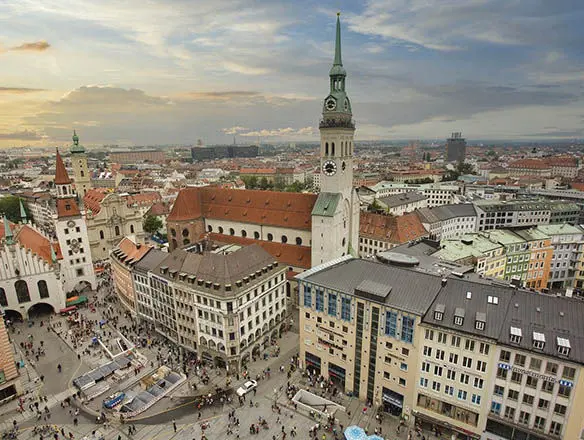
Audio 1 - Introduction
What's the first thing that comes to mind when you hear about Munich? Oktoberfest, for sure! And that's understandable since between six and seven million visitors gather yearly in the Bavarian capital for Oktoberfest. But Munich has so much more to offer! In fact, it is one of the most interesting cities in Germany, with many tourist attractions that will appeal both to culture lovers and beer fans. Munich's most outstanding feature is its historic center, which revolves around Marienplatz and its emblematic New Town Hall, places that you will discover accompanied by this audio guide (audio guides). But don't forget to relax in its parks, enter its churches, visit its museums, or drink a large glass of beer in one of its many breweries.
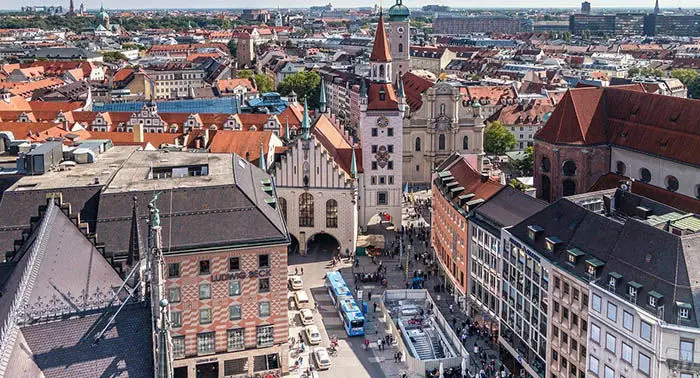
Audio 2 – Marienplatz
To start the tour, our audio guide (audio guides) offers you the opportunity to begin at Marienplatz, in the heart of Munich. This has been the city center since its foundation in 1158. Originally the square was called Schrannen, but it was renamed St. Mary's Square to ask Our Lady to protect the city from the cholera epidemic that had plagued it since October 1836. Very important events have taken place here since time immemorial, whether they were celebrations, tournaments or executions, and today it is a meeting point to go out for a drink or a meal, and to celebrate Bayern Munich victories!
The Mariensäule rises in the center, a marble column, erected in 1638, with a sculpture of the Virgin Mary at the top. It symbolizes the end of the Swedish occupation after the Thirty Years' War.
Around the square, we find the Alter Rathaus or Old Town Hall, which, with over 500 years of history, retains its Gothic appearance and a striking medieval interior. On the north side, the Neues Rathaus or New Town Hall surprises with its neogothic façade, and you can climb to the top of its tower to enjoy the views.
The New Town Hall Glockenspiel musical clock will catch the attention of everyone who passes by Marienplatz at 11:00 or 12:00. The mechanical clock is made up of 43 bells that play different melodies while 24 life-size figures represent the wedding between William V, Duke of Bavaria, and Princess Renate of Lorraine. The second scene, located at the bottom, shows the Barrel Dance celebrating the end of the Black Death, which struck the city of Munich between 1515 and 1517.
You can also find the Fischbrunnen in the square, a neo-gothic fountain that was originally used by the fisherman of the city to keep the fish alive until they were sold. Destroyed by the 1944 bombings, it was rebuilt with some parts from the original fountain.
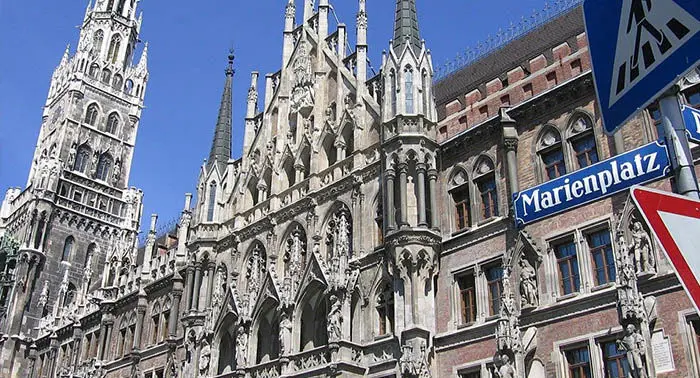
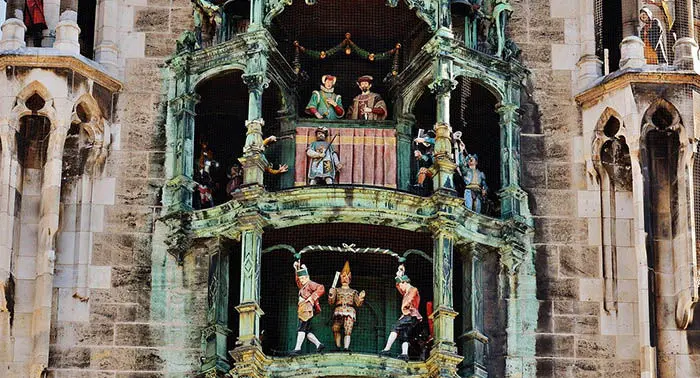
Audio 3 - The Hofbräuhaus Brewery
The Hofbräuhaus is located in a small and beautiful square in the old part of Munich. It is not just any brewery as it has a long history behind it, which we invite you to discover using the audio guide (audio guides).
Founded in 1589, the Hofbräuhaus was originally a beer-maker. It was not until 1828 that the brewery moved and it opened its doors to the public.
The Hofbräuhaus is a huge building with beautiful ceilings and huge halls filled with benches and wooden tables tight together.
This huge three-story brewery has capacity for several thousand people, making it one of the city's main tourist attractions.
Each floor and lounge offers a different atmosphere, starting with the busy ground floor, with bands, waiters, and waitresses offering souvenirs, bretzels, and huge quantities of the local beer. The first floor usually welcomes the locals and offers a quieter, more family-friendly atmosphere. Finally, the jewel of this majestic brewery is located in the highest part of the building; it is the Festsaal or Festival Hall, and as its name indicates, it is the setting for great celebrations.
Enjoy this typical Munich location, but remember to drink in moderation!
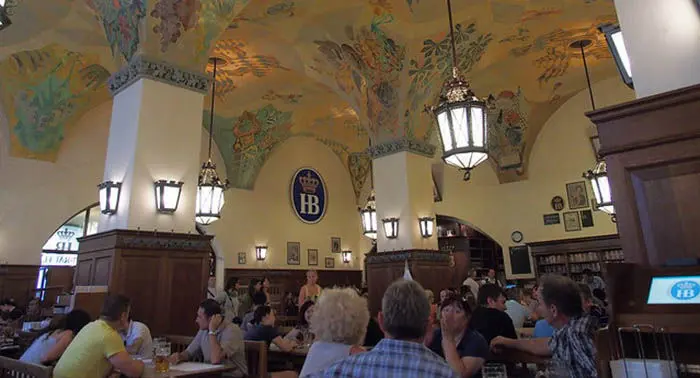
Audio 4 – BMW Museum and BMW Welt
If you like cars, take advantage of your stay in Munich to visit the BMW Museum, which offers a tour covering the history of the brand and its models.
Built next to the tower that houses the Bavarian brand headquarters, the museum was inaugurated in the summer of 1973. The exterior design was particularly innovative for the time and features a building with a hemispherical shape.
In the same way as the BMW brand itself, the museum was improving its international image, until its original format became outdated. In 2004, an ambitious modernization and underground expansion project was initiated, which was completed in 2008 with the current layout: a complex with a larger and more modern exhibition area.
In 2007, a new building was inaugurated to showcase modern brand models, the so-called BMW Welt
The result of the reorganization of the BMW Museum is a journey through the history of the Bavarian Engine Factories, from their official foundation in 1923 to the present day. During those one hundred years, the automobile industry has gone from developing motorcycles, or even airplane engines during World War II, to competing for world leadership in high-end cars.
Throughout the visit using the audio guide (audio guides), you will be able to explore this tour, based on seven different collections dedicated to design, history, motorcycles, technology, competition, the brand itself, and the development of models and series.
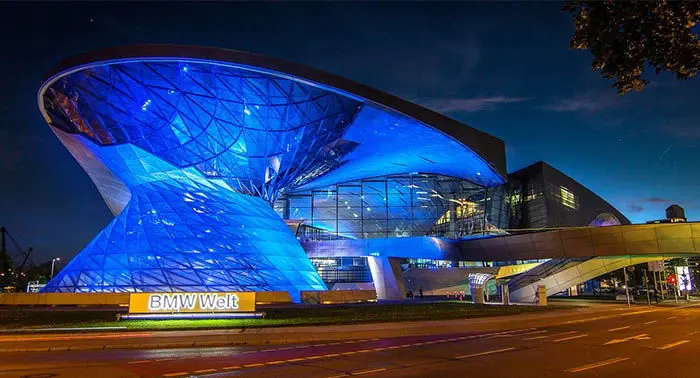
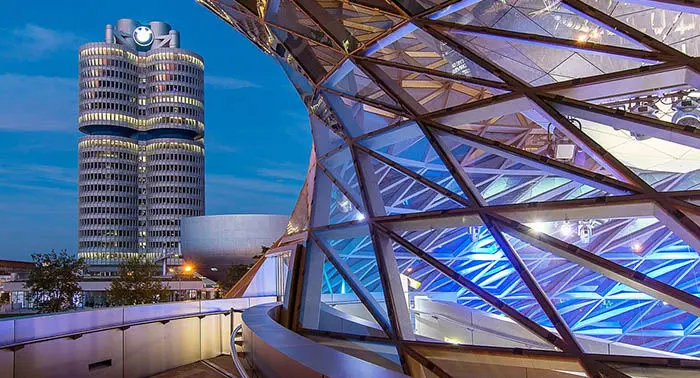
Audio 5 - Olympiapark/Olympiaturm
The Olympiapark was built for the 1972 Summer Olympic Games. Several decades later, Munich's Olympic Park is still an exceptional green zone with no shortage of attractions, used for events of all kinds. Thus, sports facilities, nature, and a comprehensive cultural and leisure program coexist in this 985,000 m2 space.
In terms of sports facilities, Olympiapark consists of the Olympic stadium, several pavilions, the ice palace, and the indoor swimming pool. While the first two are mainly used for music concerts, the ice palace allows access for everyone to enjoy the ice rink and the swimming pool is open to the general public.
If you visit Olympiapark with the audio guide (audio guides), don't forget to climb the Olympiaturm or Communication Tower. It is located in the center of the park and from its top, you will get wonderful views of the whole park and the entire city. You can also take a guided tour of the Olympic stadium.
Finally, you mustn’t forget that this great park is responsible for hosting music festivals in the summer months, among which are the Tollwood and the Theatron.
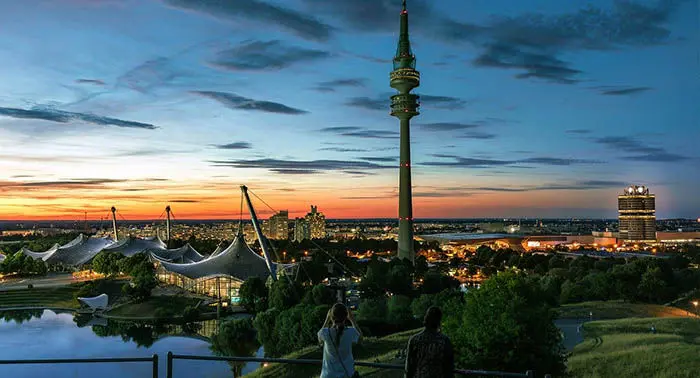
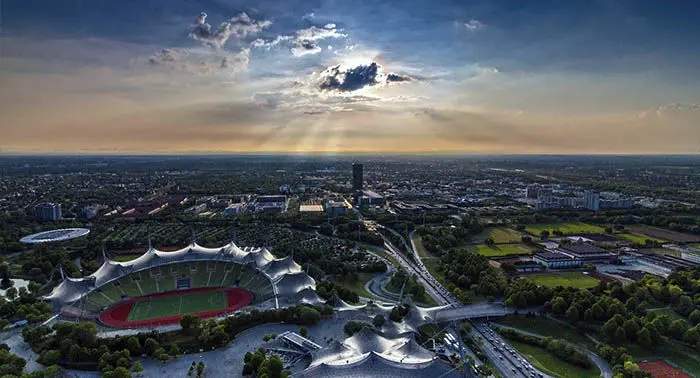
Audio 6 – Deutsches Museum
The next stop on the audio guide (audio guides), the Deutsches Museum was founded in 1903 and opened its doors for the first time in temporary rooms in 1906. The main building was opened in 1925 after a 10-year delay. The library followed in 1932 and the congress building in 1935.
After major destruction during the Second World War, it reopened in 1948.
Deutsches Museum is a science and technology museum, located on an island formed by the Isar River. Cataloged and recognized as the largest in the world in this field and one of the most visited in the world, it is estimated that it would take about 8 days to visit the entire museum. It is arranged in 50 sections over an area of 4.7 hectares. Up to 28,000 objects from among the 100,000 that make up the museum collection are currently on display in the various exhibition rooms.
Its purpose is to provide the visitor with instructive access to science, engineering, and technology, so in each part of the museum, visitors will find interactive objects. The permanent exhibitions begin with the days of the Stone Age up to today, organized in fields such as Natural Sciences, Energy, Materials, Communication, Transportation, Musical Instruments, or New Technologies.
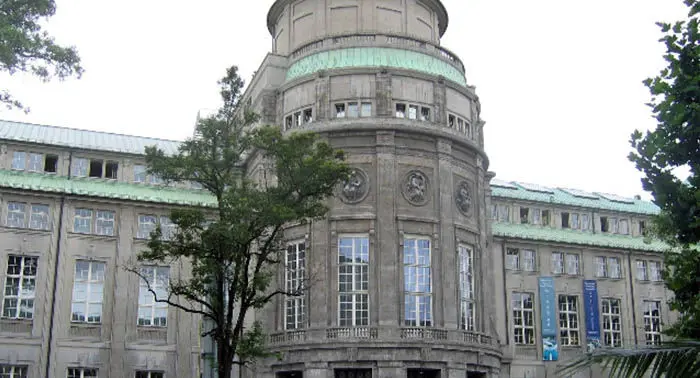
Audio 7 – Odeonsplatz
The Odeonsplatz is another big square in the center of Munich. This is a place full of history, so you need to pause the audio guide (audio guides) to observe every detail.
At the end of the 18th century, the old walls were demolished and the old Schwabing Gate was remodeled to create a monumental square and project a more imposing image to anyone entering the city.
This square is named after the former concert hall, the Odeon, which is now the headquarters of the Bavarian Interior Ministry. Next to it is another identical building, Leuchtenberg Palace, now the Bavarian Finance Ministry. Both palaces were inspired by the Farnese Palace in Rome.
In its center is the monumental Feldherrnhalle, or in English, Marshalls' Hall, stands out. This lodge was designed by the architect Friedrich von Gärtner at the behest of King Ludwig I and was built between 1841 and 1844.
Two other imposing buildings surround the square: the Residenz, which was the royal palace of the kings of Bavaria; the second, the Theatine Church, in the baroque style. Finally, the Hofgarten is a wonderful garden frequented by the inhabitants of the area, in which you can take a break before continuing your visit!
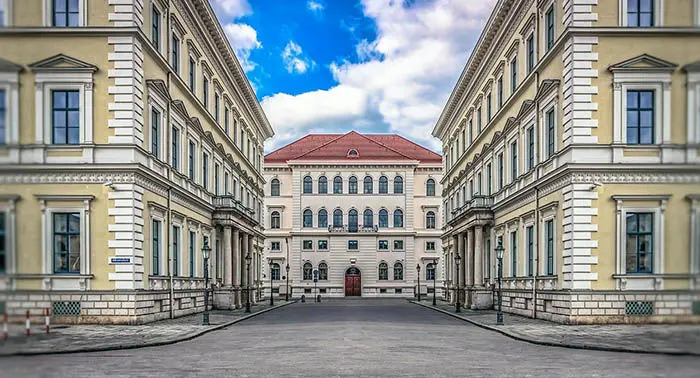
Audio 8 – Viktualienmarkt
Viktualienmarkt was born as such at the beginning of the 19th century when Maximilian I of Bavaria decreed in 1807 that the local market should be moved from the nearby Marienplatz, formerly known as Market Square.
Damaged by the air raids in World War II, its reconstruction was supported by the creation of several new fountains dedicated to local cultural personalities, such as the actor and producer Karl Valentin or the soprano Liesl Karlstadt.
The 140 stalls at the Viktualienmarkt offer a complete range of products. On an area of 22,000 square meters and right in the center of the city, you will find everything from flowers, exotic fruit, and all kinds of vegetables to cheese, sausages, meat, and fish.
In the center of the market, a biergarten, or "beer garden" offers a selection of local beers. At the adjacent stall, traditional Bavarian food is served, as well as German sausages.
Whether it is with the intention of shopping or simply to feed the eyes, to have a beer on a warm summer morning or a hot soup during the cold winter days, a visit to this market with the audio guide (audio guides) is worthwhile. Without a doubt, it is a place of sensations.
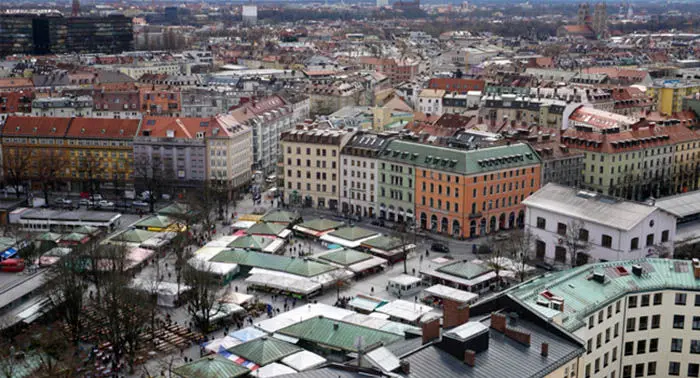
Audio 9 – Residenz
The Residenz is the former royal palace of the kings of Bavaria in Munich's city center. With its 130 rooms and 10 courtyards, it is the largest city palace in Germany, and today serves as a museum.
Originally, it was a simple castle called Neuveste, built in 1385. It was not until the unification of the Bavarian duchy in 1506 and the designation of Munich as the sole capital that the Residenz began to take on real significance. Over the next four centuries, numerous successive extensions were carried out which made it the magnificent complex we are admiring today with the audio guide, and which is a mixture of various architectural styles: late Renaissance, Baroque, Rococo, and Classicism.
The museum of the Residence opened its doors in 1920. It was heavily affected by the bombings during World War II, leaving only 50 m2 out of a total area of 23,000 m2 standing. It was then gradually rebuilt, thanks in part to Marshall Plan funds, in works that were delayed almost until 1980.
Don't miss the next audio guide (audio guides) point to discover the key areas of the Residenz!
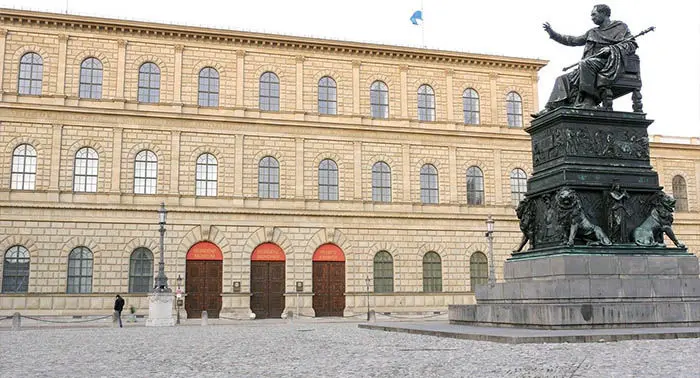
Audio 10 - Residenz (continuation)
The most recommended areas to visit with the audio guide (audio guides) are the Cuvilliés Theatre, the Antiquarium, and the Treasury.
The Cuvilliés Theatre is a splendid Rococo building created by the architect François Cuvilliés, and on which the best Bavarian artists of the 18th century collaborated. It was completed in 1750 and hosted the first performance of Mozart's Idomeneo in 1781.
Under the rule of Albert V (1550-1579) the so-called Antiquarium was built, one of the most splendid rooms in the place. Its long gallery is the largest vaulted Renaissance hall in northern Europe, and its walls display an impressive collection of classical statuary from the ancient world. The ceilings and around the windows are covered by 'grotesque' frescoes, so-called because they imitate the ancient Roman frescoes.
Finally, the Residenz Treasury displays the jewels of the Wittelsbach family along with a number of religious treasures from Bavarian churches and monasteries. Among the oldest works is a Romanesque crucifix dated 1006 that belonged to Queen Gisela; one of the most recent works is the Bavarian royal crown from 1806. The most spectacular work, however, is a magnificent statuette of St. George slaying the dragon, a Renaissance masterpiece made for Wilhelm V around 1597.
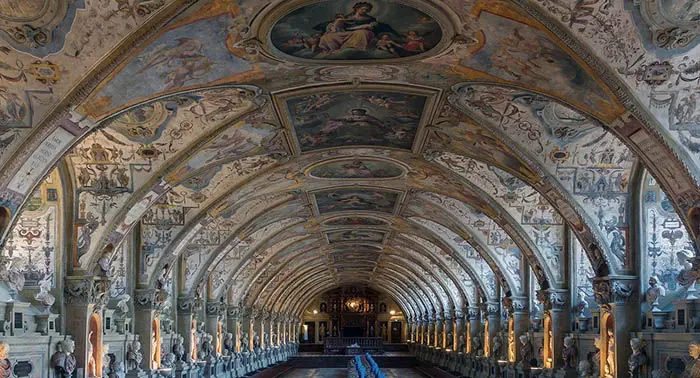
Audio 11 – Karlsplatz and the Karlstor Gate
A crossroads that is one of the main hubs for the public transport network, Karlsplatz is one of the largest and busiest squares in Munich. It offers us access to the historical center from the west, through a gate of medieval origin known as Karlstor.
It is important to note that in the Middle Ages, the city of Munich was protected by a wall, which was demolished in the 18th century to allow the city to expand. Of the four gates that the fortified city had, only three remain: Karlstor, Isartor, and Sendlinger Tor.
The Karlstor gate was initially known as Neuhauser Tor and had 3 towers. It was in rename with its current name in 1797, after the construction of Karlsplatz square. In 1861 a gunpowder explosion forced the demolition of the gate which was later rebuilt in Gothic style.
The square was also officially renamed Karlsplatz in 1797 by the Bavarian Duke, Charles Theodore of Wittelsbach. The architect of the demolition of the medieval wall and the first expansion outside the walls, Karl Theodorus did not, however, enjoy the favor of part of the local population, who chose to continue calling it Stachus, as in the past. This name was connected to a brewery that existed on a corner of the square in the 18th century and which, two centuries later, has remained the official name of the site.
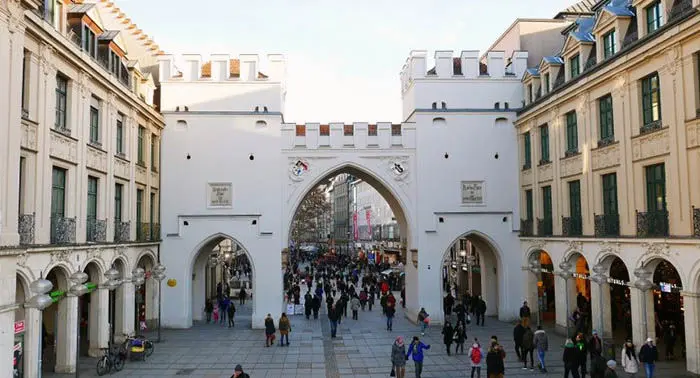
Audio 12 – Saint Michael’s Church
Another of Munich's most beautiful monuments to visit with the audio guide (audio guides) is St. Michael's Church. It is the largest renaissance church north of the Alps. It was built in two stages between 1583 and 1597 by William V Duke of Bavaria, as the spiritual center of the Counter-Reformation. Sculptures in its facade represent the success of Catholicism over Protestantism. Of these sculptures, the one that causes the most excitement is that of the fight between Saint Michael and the dragon.
The interior of this sensational church houses the second-largest barrel vault in the world, the first being St. Peter's in the Vatican at 20 meters in height. The high altar and the decorative scenes inside St. Michael's are dedicated to Jesus.
It should be noted that Saint Michael's was damaged during the bombing of Munich in World War II, so it had to be restored later.
Moreover, its crypt houses the tombs of some prominent members of the Wittelsbach dynasty, including William V of Bavaria himself and Ludwig II, also known as “the Mad King.”
Another tomb worth visiting is that of Eugène de Beauharnais, the adopted son of Napoleon and Duke of Leuchtenberg, and heir to the Grand Duchy of Frankfurt in 1810.
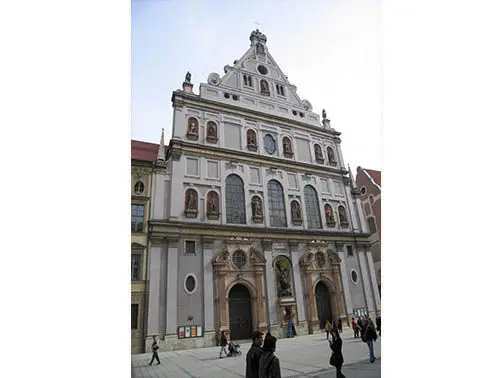
Audio 13 – Nymphenburg Palace
With the poetic name "Palace of the Nymphs," this majestic palace is the former summer residence of the Bavarian royal family, the Wittelsbachers. It is a huge and eclectic Baroque-style complex from the 17th century, which is in fact one of the largest palace complexes in Europe. It houses several museums and a huge English-style garden dotted with pavilions.
Nymphenburg has a richly decorated interior that still retains its period decor, so you will see beautiful frescoes, a collection of portraits, a beautiful Rococo-style ballroom, and many rooms that still appear to be inhabited.
The palace has a beautiful garden of distinct English style on more than 800,000 square meters of land. Over the years this garden was remodeled in different styles while increasing its size until it became the pleasant and surprising space that it is today.
The garden has several buildings that are worth visiting: In this audio guide (audio guides), we will highlight the Amalienburg, a small independent palace with a spectacular rococo decoration; the majestic baths of the Badenburg pavilion, inspired by the ancient Roman baths; Pagodenburg, a coquettish construction that served as a resting place after the games of "Mailspiel," a game similar to golf that was played at the time; and the Chapel of the Magdalene, which is a small church that was intended to bring a religious and contemplative aspect together with the amusements that characterized court life.
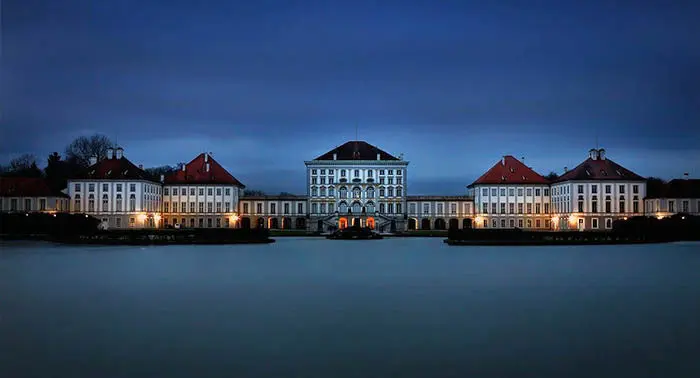
Audio 14 – Englischer Garten
The English Garden is one of the largest urban gardens on the planet, even larger than London's Hyde Park or New York's Central Park. It is one of the main tourist attractions, as well as functioning as a green lung for the locals. It extends over 417 hectares full of trails, streams, and groves.
It was conceived in 1789 by Benjamin Thompson, an American scientist temporarily stationed in the city as a royal advisor. Designed at the request of the elector, Charles Theodore, it was a revolution as it became a large public access space.
As you walk along with the audio guide (audio guides), observe the Chinese Tower (Chinesischer Turm), a wooden tower built at the end of the 18th century. Today, this curious tower is surrounded by a gigantic beer garden with about 7,000 seats, usually crowded on hot summer days. Other places of interest are the Japanese house, a small monopteral temple, or a piece of the Berlin wall.
And as surprising as it may seem, surfing is possible in Munich! The waters of Englischer Garten are used not only by bathers but also by groups of surfers who practice their favorite sport on the Eisbach's surfing wave.
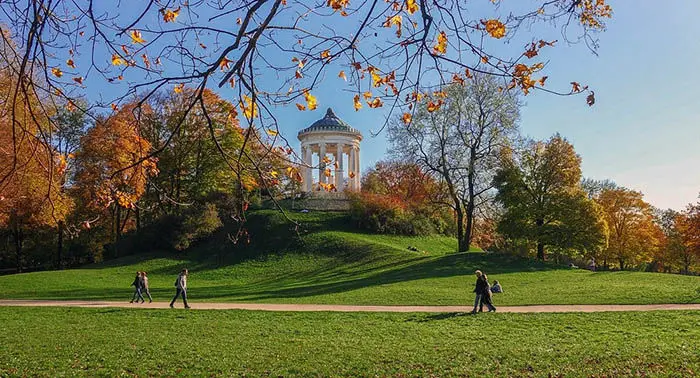
Audio 15 - Oktoberfest
Oktoberfest is undoubtedly Munich's most famous event, and a local experience not to be missed! When you hear this word, huge beer mugs, waiters and waitresses in traditional costumes, and many, many laughs come to mind, but do you know the history of Munich Oktoberfest? We invite you to listen carefully to this chapter of the audio guide (audio guides) because culture and fun can go hand in hand!
We have to go back to October 12, 1810, when Prince Ludwig of Bavaria, son of King Maximilian I, married Princess Theresa of Saxony. For the festivities, all the citizens of Munich were invited to participate in a large party in the meadows outside the city walls, a celebration that lasted 5 days.
This first celebration bore little resemblance to the present one. To close the celebrations, a horse race was organized which was so well received that the decision was made to repeat it the following year, and so on until 1960, originating a long tradition that has only been canceled 24 times throughout its more than 200 years of history, mainly due to wars and epidemics. The place of celebration was later renamed " Theresienwiese."
The following year, in 1811, alongside the horse race, an agricultural fair was also organized with the aim of promoting the Bavarian economy. This fair would later become independent and is now held every four years.
In 1950, what is now the traditional opening ceremony of the festival was presented for the first time, where the mayor of Munich and a figure representing the Münchner Kindl (the figure on the official city coat of arms) lead the parade. They are followed by ostentatious horse-drawn carriages laden with beer barrels, the carriages of the Wiesnwirte (as brewery owners are called), and the fairground owners. The bands that will later play in the tents also accompany the parade.
So, on the first Saturday after September 15, at noon, the Mayor of Munich opens the first keg of beer in the Schottenhamel tent to the cry of "O 'zapft is!", which means, "It's finally open!" Immediately afterward a twelve gun salute is fired from the steps of the statue representing Bavaria. This is the signal for the Wiesnwirte to start serving the long-awaited beer.
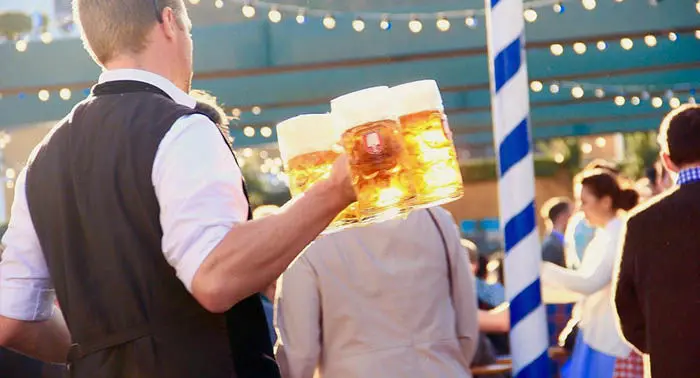
Audio 16 - Oktoberfest Beers
Before you start tasting the local beers, our audio guide (audio guides) suggests you learn about the different brands you will find!
Only one type of beer known as Oktoberfestbier is served inside the Oktoberfest tents, an appellation of origin that only includes beers brewed within the city limits of Munich and that strictly comply with the German Purity Law. The Purity Law was decreed in 1516 by William IV of Bavaria and states that beer should only be brewed from three ingredients: water (preferably spring water), malted barley, and hops.
More specifically, you can enjoy 6 beers that we describe in the following clips.
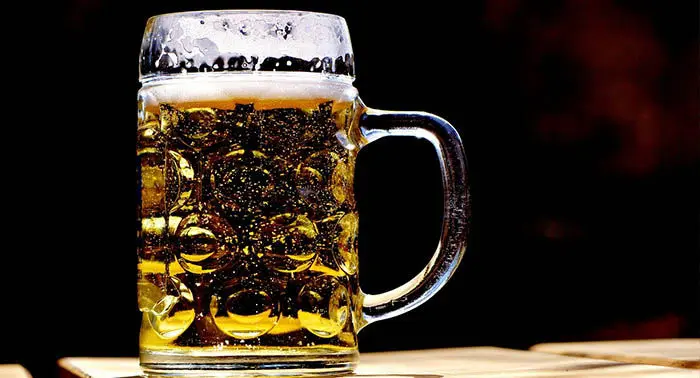
Audio 17 - Augustiner Bräu
Augustiner Bräu is the oldest brewery in Munich under its original name. The label design has remained unchanged for decades. It is the only one to serve the beer in traditional wooden barrels. It has an alcohol content of 6.3% and is served in the tents of Augustiner Festzelt and Fischer Vroni.
Audio 18 - Hacker-Pschorr
Hacker-Pschorr is known for its curious bottle with a flip-top lid. For the event, it brews a golden-colored beer, crowned with magnificent white foam. It has a subtle mix of dry bread and caramel notes, offering delicious malty flavors while in your mouth that culminate in a hoppy finish. It has 5.8% alcohol and is served in Hacker-Festzelt and Pschorr Bräurosl tents.
Audio 19 - Hofbräu Munchen
Hofbräu Munchen is the official brewery of the state of Bavaria, and traditionally brews the festival's most alcoholic beer at 6.3% and serves it in the festival's largest tent. It has a slightly malty taste, with body, maturity, and with an elegant finish in the mouth. Malting is a process applied to cereal grains, which are made to germinate by immersing them in water, and then quickly dried with hot air to give them a toasted flavor.
Audio 20 - Löwenbräu
Löwenbräu (Lion's brew) brews a traditional beer for the festival. It has a complex and refreshing taste, with a sweet flavor that lingers on the palate. It has an alcohol content of 6.1% and is served in its official tent, the Löwenbräu-Zelt and the Schützenzelt. The tent has a 37-meter-high tower and a lion that roars every minute.
Audio 21 - Paulaner
Paulaner is the event's most famous brand. It produces a low-fermentation beer for Oktoberfest with a perfect balance between a light hopping note and the strong taste of malt. It's festive, tasty, and wonderfully light on the palate, a variety only available during Oktoberfest. It has 6% alcohol and is served in Winzerer Fähndl, Armbrustschützen-Zelt, and Käferzelt.
Audio 22 - Spaten
Every year in March, the shovel brand produces a brightly colored, clean beer with a white head and the characteristic aroma of bread and malt for the traditional Oktoberfest festival. With an initial sweet taste, it ends slightly bitter. According to them, it is the festival's number one beer. It has an alcohol content of 5.9% and is served in several tents: Marstall, Ochsenbraterei, Schottenhamel, and Spaten-Zelt.
Now it's time to try them out by toasting best friends. Enjoy Munich!!!
Audio guide devices, Multimedia audio guides,
Audio guide GPS tourist bus-train, charging bases and accessories.
Group guidance systems, headsets, charging cases, tour guide systems accessories.
Audioguides available from mobile devices, web App, downloadable App from Google Store.
Audioguides in several languages, translations, voiceovers. Audio descriptions, signoguides, visual contents for audioguides. 3D Reality.